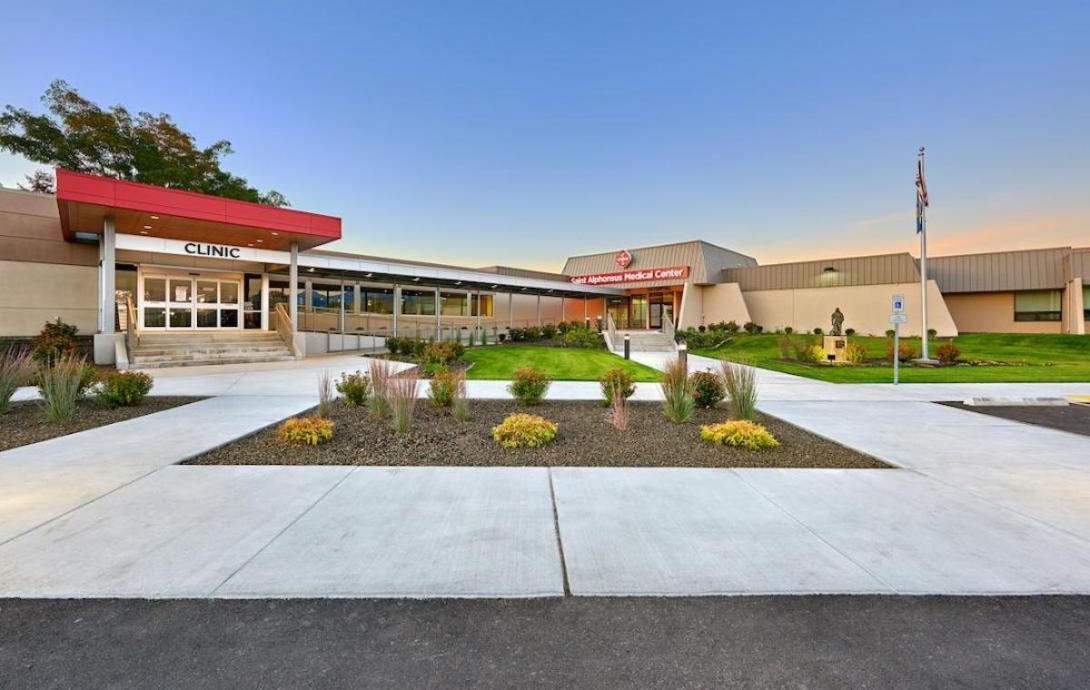
Federal and Oregon officials hope a potential emergency deployment of U.S. government nurses will persuade one of the nation’s largest hospital chains to reverse its sudden and controversial move to eliminate maternity services at Baker County’s only hospital.
But even if federal officials agree to send six federally-paid obstetrics-trained registered nurses to Saint Alphonsus Medical Center, it’s unclear whether that will convince the small Eastern Oregon hospital and its parent, the nonprofit Catholic Michigan-based chain Trinity Health, to keep the birth center open.
The hospital in June announced it would shut the center on July 31 due to declining use and the difficulty of hiring specialized staff. The move sparked safety concerns, with some noting that it could force families to drive more than 40 miles through a mountain pass that can be treacherous or unpassable in winter.
The move is among many by hospital systems nationwide to cut unprofitable or hard-to-staff services, such as birth centers, as hospitals try to regain operating profitability coming out of the pandemic. Meanwhile, mortality rates across the country have grown, more than doubling in some states, studies show.
The 36-bed hospital reported a record loss for 2022, following record profits in 2020-21.
The looming closure alarmed state officials , but they cannot legally force Saint Alphonsus to keep the maternity unit open.
Gov. Tina Kotek asked the United States Public Health Service to send a half-dozen registered nurses to the Baker City facility for six to 12 months to keep the birth center open and give the state and the hospital time to put permanent staffing in place.
Oregon’s U.S. Sens. Ron Wyden and Jeff Merkley on Monday released a letter urging the federal public health agency to approve the request. They said the state doesn’t have the needed funding.
Saint Alphonsus officials have not confirmed whether they will stick with the July 31 deadline or extend it, but recently expressed an openness to delaying it.

On Monday, they did not immediately provide responses to The Lund Report’s questions about the staffing makeup of the hospital’s maternity unit or what level of help from the federal government could ensure it stays open.
But after Wyden and Merkley raised the possibility of help from the Public Health Service and other ideas in a July 10 letter, a Trinity Health executive, Odette Bolano, responded that system officials were pursuing the “resources” they’d cited to “potentially temporarily maintain” the birth center, adding “we appreciate your willingness to work together.”
Births at the maternity unit have been trending down in recent years. Preliminary state data show 100 births there last year, down from an average of about 125 in the 2010-2020 period.
But because other hospitals are so distant, the service is vital for the county of 17,000 residents, community leaders say.
It could take Baker County residents an hour or possibly much longer to reach maternity units in other hospitals in other counties. Community leaders have pleaded with the Boise-based Saint Alphonsus system to keep the maternity unit going.
The drive to the nearest hospital – in La Grande – “can be treacherous in the winter, and the route is frequently closed, leading to commutes as long as three hours,” the senators wrote to the federal health service.
The Baker City hospital and Boise-based Saint Alphonsus are part of Trinity Health, the fifth-largest hospital system in the nation. Like many other hospital systems, Trinity in recent months has incurred operating losses due to sharply rising labor costs that have outpaced revenue growth.
In the six months ended Dec. 31, 2022, the system, with 88 hospitals nationwide, incurred an operating loss of $297 million on operating revenues of $10.5 billion. But other revenues, including returns on the system’s $5 billion investment portfolio, cut the loss for the six months to $33 million, according to the system’s financial filings. The system has a net worth — all assets such as investments and buildings, minus liabilities such as debt — of $17 billion, according to the filings.
The Baker City hospital is a tiny part of the system. Prior to the pandemic, the hospital had long been financially steady and unspectacular, typically hovering around breakeven point on revenues of about $30 million a year, losing some money some years, making a small profit in others, according to filings with the Oregon Health Authority.
In 2020-21, its revenues soared to $41 million a year, due in part to a total of $4.7 million in federal pandemic aid from the Department of Health and Human Services. The hospital reported profits totaling $10 million in those two years.
But as federal aid ended, the hospital finances sagged in 2022. Its expenses rose, its revenues dropped to $36 million, and it reported a loss of $3 million, its largest in the Oregon Health Authority’s database, which goes back to 2007.